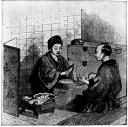|
|
|

Goals
This topic is divided into the following sections:
- Objectives, including business objectives
and content objectives
- Evaluation, including Level 1 (reaction),
Level 2 (learning), Level 3 (behavior), and Level 4 (impact).

Objectives
Business objectives
- As a group, learners must demonstrate immediately on the job
each skill learned or improved in actual business correspondence,
measured in the first year by:
- A 50% reduction in transaction completion time,
- An 80% reduction in notes that need clarification or apologies with follow-up notes, and
- A 90% reduction in costs directly attributable to misunderstanding in correspondence.
- Increased facility with English by Japanese businesspeople
must by the year 2007 result in a 50% increase in "English business"
market share (contracts coming to Japan that formerly went to other countries,
traditionally better with English).
Content objectives
The first two of the following content objectives take into account MITI's
request that the course should build on whatever English skills are already
possessed by the learner.
Except for the first one, each of the following content objectives
describes what the learner will be able to do at the conclusion of the course.
The learner will be able to:

- Satisfy the prerequisite of a certified TOEIC score of 550.
- Either:
- Improve the entry TOEIC score by 20 percent.
Or:
- Attain a TOEIC score of at least 700.
- Write with correct grammar, syntax, spelling, usage, and accepted style,
as prescribed or recommended by accepted authorities and guidelines
(Webster's, Chicago Manual, and so on), measured by an 80% reduction in errors in the first year.
The learner will be able to do the following:
- Use appropriate articles (a, an, or the), and
avoid an article when it is not appropriate.
- Distinguish active and passive voice, explain when each voice is appropriate,
and use voice appropriately in sentences.
- Identify improper shifts of tense, of person, and of mood;
and write sentences without such improper shifts.
- Identify modifier problems (misplaced modifiers, dangling modifiers,
and so on) in given sentences, and write sentences using modifiers appropriately.
- Identify problems with emotion words (for example,
"I am irritating by this situation" and
"This situation is irritated"),
and write sentences using emotion words appropriately.
- Identify nominalizations, explain the limited situations when they aid communication,
use them in writing only in those situations, and--in places
where nominalizations are typically used inappropriately and excessively--write
with action verbs instead.
- Identify problems with parallelism, successfully correct the problems,
and write sentences using parallelism appropriately.
- Identify problems with long noun strings, successfully correct the problems,
and write sentences avoiding long noun strings by using appropriate phrasing.
- Identify problems with deadwood, successfully correct the problems,
and write sentences without redundancies and other unnecessary words or phrases.
- Write the different parts of a note (opening, development, closing),
using commonly accepted usage conventions.
- Write e-mail notes that are comprehended the first time, determined by the recipient
not asking for a clarification in a follow-up note.
- Write with the appropriate tone, a tone that makes the desired
impression and does not offend, measured by the recipient not taking offense,
necessitating apologies in a follow-up note.
- Write the type of e-mail appropriate for each business situation
(identify the type of any note, and name the type that would be appropriate
in a given set of circumstances):
- Request or inquiry note
- Acknowledgment note
- Confirmation note
- Congratulations note
- Acceptance or approval note
- Rejection or refusal note
- Complaint note
- Disagreement note
- Apology note
- Introduction or recommendation note
- Invitation note
- Gratitude note
- Write a note that a recipient could not guess was written by a non-native
English speaker.
- Reply, without assistance, to received English e-mails within 24 hours.
- Distinguish good business writing from bad business writing by
identifying examples of each and explaining the qualities that make the writing good or bad.
Back to the top

Evaluation
Evaluation is included in our design document from the beginning,
so that we ensure we have built accountability in and that we will have a way
to know whether we achieve the objectives we have set.
After the course is delivered, we compile Level-1 evaluations, receive Level-2 results,
initiate Level-3 evaluations, and receive reports indicating Level-4 results.
We will be investigating anomalies and periodically summarizing and reporting our findings.
From evaluations and from our in-staff post-mortems,
we can learn from our mistakes and improve what we do.
Level 1 (Reaction)
 How do the learners feel about the course?
We are including a sample evaluation form for the learners' reactions.
The form will actually be written in Japanese.
If the course is to be delivered as computer-based training
(CBT)--a determination that will not be made until the topic
Instructional strategies,
Delivery medium--the
evaluation form will be a feedback form HTML page that the learner can submit to a
CGI (Common Gateway Interface) program running on the server.
How do the learners feel about the course?
We are including a sample evaluation form for the learners' reactions.
The form will actually be written in Japanese.
If the course is to be delivered as computer-based training
(CBT)--a determination that will not be made until the topic
Instructional strategies,
Delivery medium--the
evaluation form will be a feedback form HTML page that the learner can submit to a
CGI (Common Gateway Interface) program running on the server.
The Edmands team have some design concerns they hope can be addressed
in the course evaluation phase.
After examining the evaluations, the team will be able to make any necessary corrections.
Among the concerns is the possibility that--if the course is to
be delivered as CBT--the software in the submodule might be "obese,"
full of function that will rarely if ever be needed and
that will take far too much time to load.
Recognizing the tendency to "spray and pray" (spray as much as possible onto the students
and pray that some of it will stick) with an audience from a different culture,
the team worked very hard in drafting the course objectives to ensure the relevance of the
material.
Nonetheless, in the online feedback page they include questions about relevance.
Items in the evaluation that apply only if the course is delivered as CBT
are highlighted in italic blue.
Those learners who choose to be "reminded in a day" will be sent a reminder e-mail,
with a direct link to the survey.
The course administrator will also send a separate e-mail to each learner
immediately after course completion, offering an incentive for completing the feedback
within 3 days.
After clicking the Send form button on the form,
the learner will see a "Thank you" message (in Japanese).
|
Note to Saul:
Please use the form yourself, rather than merely examining it for Level-1 evaluation
criteria.
The form really works, provided you are connected to the Internet.
In the input fields of the form, especially the one prompting "Please write additional
questions or comments here," you can evaluate the entire project if you like.
Unfortunately, however, you cannot
enter a great deal of text there: You have eight lines or so before the field scrolls;
you can enter more text by scrolling down, but the CGI program will truncate it.
(We will fix this in the actual e-mail course, of course.)
After you click the Send form button, I will receive your comments (within a day),
and you are taken to a generic IBM "Thank-you" page, entitled "Contact IBM."
(Be assured that the "Thank-you" page for the e-mail course will be a bit more
imaginative.)
To return here, simply click out of the window containing the IBM page.
|
|
To see the Level-1 evaluation,
go to the feedback form.
 How much did the learners actually learn in the course?
The following is a sample of a test presented to the learner at the conclusion of the
submodule "Easy business e-mail in English."
Like the level-2 tests in the other modules of the comprehensive business English course,
it is similar to the TOEIC.
How much did the learners actually learn in the course?
The following is a sample of a test presented to the learner at the conclusion of the
submodule "Easy business e-mail in English."
Like the level-2 tests in the other modules of the comprehensive business English course,
it is similar to the TOEIC.
1. Insert the appropriate article in the blanks. If no article
is required, insert an X:
I like ___ apples, ___ pears, ___ peaches, ___ grapes, and
___ oranges. In other words, I like ___ fruit. I bought some
apples and pears yesterday. ___ apples were delicious. But
___ pears were not so good because they were too ripe.
Several fires were reported in ___ city last night. ___ largest
fire was in ___ lumber mill. Two restaurants had ___ kitchen fires.
___ dozen or more automobiles had ___ electrical fires. All of ___
fires were brought quickly under ___ control by ___ local fire
department. Only ___ few injuries were reported, none serious.
___ injuries were mostly to ___ firemen.
2. Change each of the following sentences from the passive voice
to the active voice, if it is appropriate. However, if it is better
to leave the sentence in the passive voice, write "OK" in the field.
A report for each flight was written by Veda technicians.
A glossary is included at the back of the book.
When this switch is set to TEST, the transmission can be
checked by the serviceman.
3 The following sentences have problems of shift of person,
shift of number, or shift of tense (or combinations of these
shifts). Rewrite the sentences to correct the problems.
When you press the Enter key, the menu will appear.
One can use a telephoto lens to produce their close-up shots.
We call the result output, which are characters or pictures
displayed on a screen or printed on paper.
When the first wheels were made about 6000 years ago, you
could move very heavy loads.
Every experiment we do in this laboratory must have a specific
aim, and they must be performed with the appropriate apparatus.
4. The following sentences have problems of placement of modifier.
Rewrite the sentences to correct the problems.
Sailing around the bend, the lighthouse came into full view.
The sample to be analyzed first must be put into solution.
After calibrating the manometer, three patients were found
to have high blood pressure.
Pressing the ON button, the motor starts.
5. Choose the appropriate words to complete the sentence:
I believe you will be _______ with this narrative.
__fascinated __fascinating
Computer science is an ______ subject.
__interested __interesting
Many of the students are ______ by the professor's lectures.
__bewildered __bewildering
6. In the following sentences, change unnecessary nominalizations
to active verbs and get rid of dummy verbs and other unnecessary
words:
The enclosed report provides an explanation of magnetic forces.
Figure 6 is an unnecessary duplication of Figure 3.
We are achieving the replacement of copper telephone cables
with optical fiber cables.
The researchers who effected the initial development of the
Internet used e-mail extensively in the exchange of information.
7. In which of the following sentences is the either-or construction
used correctly? Place an O by each correct sentence and an X by
each incorrect one.
__ You can operate your CD player from either the deck or from
the remote control.
__ You can operate your CD player either from the deck or from
the remote control.
__ You can operate your CD player from either the deck or the
remote control.
__ Either you can operate your CD player interactively from
its remote control, or you can set it up for automatic operation.
__ You can operate your CD player either interactively from its
remote control or automatically through a saved program.
__ You can use this adapter with either your CD player or
your TV set.
__ You can either use this adapter with your CD player or
your TV set.
__ You can use this adapter either with your CD player or
your TV set.
__ You can use this adapter either with your CD player or
with your TV set.
8. Decipher the following noun strings using phrasing:
message-handling automation functions
computer system problem isolation manual
information systems communications support group
9. Rewrite the following sentences, getting rid of unnecessary
words:
When all of these ingredients are combined together, a mild
chemical reaction will occur inside of ten minutes and an
unpleasant odor will spread throughout the entire room.
A considerable number of people have a tendency to write
long, windy sentences.
The gears may be cleaned with the aid of a cleaning solvent.
Interim results will be reported during the course of the
investigation.
The liquid was blue in color.
It is necessary that the device be fabricated with precision
in view of the fact that it will be used in connection with
very fast circuits.
10. From among the following e-mail openings, select the best:
Harold-san, Let me introduce myself. My name is Mikio Yamada,
and I am reporting to Y. Hayashi of AP Technical Solutions.
Brown: I was introduced to you from Mr. Tanaka. This is my first
note to you.
Dear Mr. Brown: I have been referred to you from Masaomi Tanaka
concerning support issues for our software contract.
Brown-san! Hello, My name is Mikio Yamada. I belong to AP SW
Technical Support.
11. From among the following e-mail closings, select the best:
Maybe you are a little tired. Take care of yourself.
Regards, Mikio Yamada, AP Technical Solutions
Regards, M. Yamada. P.S. I'm anxious for your stomach.
Bye, M. Yamada
12. Look at the following e-mail. Identify the single word
that might render the entire note offensive to the reader:
Hi, Fiona.
Thanks a lot for sending me the new Redbooks. I feel it's
great. Anyway, I had translated a Redbook into Japanese
last year. It's successfully distributed for IBM Japan SE
and customers.
The word is: _________________________
13. Look at the following acceptance e-mail, whose sentences
are numbered. Identify the one sentence in this otherwise
satisfactory e-mail that is problematical.
1Subject: STC Regional Conference
2Dear Mr. Danjou:
3Thank you for inviting me to address the STC regional
conference in Miami on August 3. 4I am happy to accept.
5As you suggested, I will speak on the code recursion modules.
6I am not sure how much time you have allotted me. 7Will
you please let me know?
8Sincerely,
9Miyuki Nishitani
10Software Engineer
11Windup96 Software, Inc.
__1 __2 __3 __4 __5 __6 __7 __8 __9 __10 __11
Which of the following is the problem with the sentence
you have identified?
__Such a sentence is an ungracious and unnecessary
amplification.
__Such a sentence should not be in that position
in the note.
__Such a sentence is likely to offend the recipient.
__Such a sentence reveals a lack of self-confidence.
14. The following is an unsympathetic rejection letter.
Revise it to make it more sympathetic, while still
denying the position.
Dear Ms. Neumann:
Your application for the position of Junior Programmer at
Windup96 Software has been rejected. We have found someone
more qualified than you.
Sincerely,
M. Kashiwagi
Manager, Arctex Programming Development
_______________________________________________________
_______________________________________________________
_______________________________________________________
_______________________________________________________
_______________________________________________________
_______________________________________________________
_______________________________________________________

Level 3 (Behavior)
How much of the training is actually transferred to the job?
Level-3 evaluation is planned for 6 months after the learner's course
completion through the following:
- A TOEIC-like test, similar to the Level-2 test, given to the learner.
- A survey, written in Japanese, of supervisors of the learner's skill
with business English.
Level 4 (Impact)
 What is the impact on the learners' companies in business terms?
Level-4 evaluation is planned for 1 year after the course completion by
the learner's group (department, division, or company).
It will be a survey, written in Japanese, of executives measuring the
achievement of the business objectives:
What is the impact on the learners' companies in business terms?
Level-4 evaluation is planned for 1 year after the course completion by
the learner's group (department, division, or company).
It will be a survey, written in Japanese, of executives measuring the
achievement of the business objectives:
- What is the reduction (in percent) since a year ago of transaction
completion time in this group of learners?
- What is the reduction (in percent) since a year ago of notes that
needed clarification or apologies with follow-up notes among this group of learners?
- What is the reduction (in yen) since a year ago directly attributable
to misunderstandings in correspondence among this group of learners?
A second Level-4 evaluation is planned for 5 years after course completion
by the learner's group (department, division, or company).
It will also be a survey, written in Japanese, of high-level executives,
to assess the increase (in percent) of "English business" market share
(contracts coming to Japan that formerly went to other countries,
traditionally better with English).
Back to the top
Go to the next topic, "Instructional strategy"
|
| |
|
|
|

